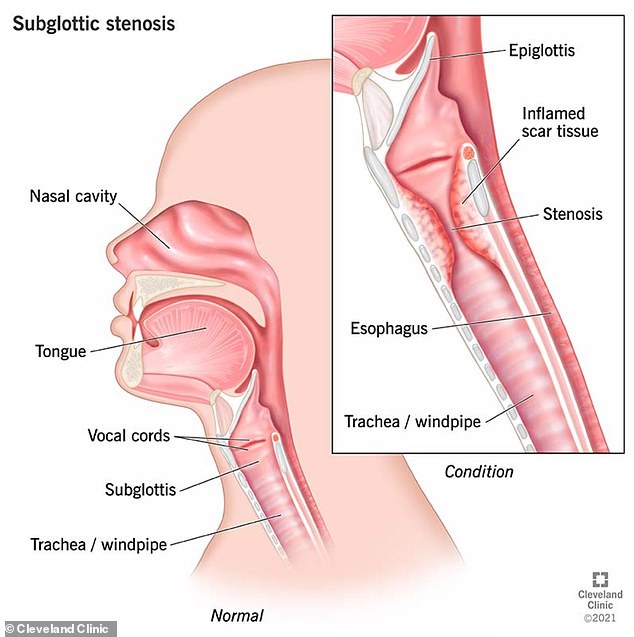A young boy has been in a vegetative state for six years after his brain was deprived of oxygen during surgery his family considers unnecessary.
Carlos Blanco, now eight years old, was born with subglottic stenosis, a narrow airway that can cause babies to wheeze or have difficulty breathing.
While many children are advised to wait and get over this, the Blanco family was told that their son needed an operation to widen his windpipe.
But during the surgery, Carlos, then two years old, suffered cardiac arrest that cut off the blood supply to his brain.
After doctors finally managed to restart his heart, he suffered severe brain damage, as lack of oxygen had caused brain cells to die.
His family is now suing his doctors and the New Mexico hospital, claiming their actions robbed the boy of his young life and caused him “significant, debilitating and permanent injuries.”
Carlos Blanco in the photo before undergoing surgery at two years old
Carlos is “just surviving” today and can only breathe through a machine that must be constantly monitored and cleaned.
His eyes are open, but he can’t talk, walk, feed himself, dress himself, go to the bathroom, or do anything a child his age would normally be able to do.
Carlos’ case was revealed in court documents in the First Judicial District of Santa Fe, New Mexico.
The boy had undergone two procedures to widen his airway in April and June 2018 at Presbyterian Hospital in Albuquerque, New Mexico, and both were successful.
But after she developed a new cough, her surgeon, Dr. Jonathan Owens, who worked in Las Cruces, New Mexico, near the family home, recommended that she undergo a third surgery in September of that same year.
Dr. Owens offered to perform the surgery himself so the family could avoid traveling to Albuquerque, about 200 miles away, for the third time, which they agreed to.
It was during this procedure, according to court documents, that the then two-year-old suffered cardiopulmonary arrest, or a medical emergency in which the heart stops beating.
Doctors performed CPR, but Carlos’ brain was deprived of oxygen for too long, causing serious damage. He was diagnosed with an anoxic brain injury.
Court documents suggest the cardiac arrest was “mismanaged” for 15 minutes, during which CPR was performed and medications were administered.
Brain tissue is very sensitive to a disruption in oxygen supply, and brain cells begin to die within minutes of low oxygen, according to the study. Cleveland Clinic.
After his heart started working again, doctors discovered that Carlos couldn’t breathe on his own and the boy had to be on a ventilator for 13 days.
After two weeks, doctors performed a tracheostomy, a procedure that creates an opening in the throat to insert a tube to allow the person to breathe.
Carlos was discharged on October 9, 2018 to his mother Josefina Blanco, and subsequently returned home where he has been in a vegetative state since then.

After surgery, Carlos (pictured above before surgery) was left in a vegetative state.
Carlos is not expected to recover and now requires 24-hour care and a breathing machine.
Carlos’ mother is suing Memorial Medical Center hospital in Las Cruces, New Mexico, and Dr. Owens, an otolaryngologist (also known as an ENT) who recommended and performed the operation, for medical malpractice.
She is seeking an undisclosed sum for her son’s “significant, debilitating and permanent injuries.”
Lawyer Adrián Vega, who represents Carlos and Josefina, said in a statement: ‘In this case, we have a young child in a vegetative state who requires 24/7 care.
“(Subglottic stenosis) is an airway problem that usually, in most children, goes away once they reach toddlerhood, so they actually go away with age.”
In a statement to Las Cruces Sun-NewsA Memorial Medical Center spokesperson said, “As a matter of practice, MMC does not comment on active litigation and federal law prohibits us from discussing any patient-specific matters.”
Memorial Medical Center and Dr. Owens did not respond to DailyMail.com’s requests for comment.
Carlos, who is a twin, had a mild to moderate form of subglottic stenosis, which caused him breathing problems but did not lead to him being regularly hospitalized, a source close to the case told DailyMail.com.
There are no formal guidelines on whether children with a mild form of the condition should have surgery, but doctors say this is usually a decision between doctors and parents.
But Dr. Satyanarayan Hegde, a pediatric pulmonologist at Access Pediatric in Florida, said that if a child had a mild case but was recovering well, he would probably opt to “wait and see” rather than operate.
He told DailyMail.com: ‘If I do some investigation and find some subglottic stenosis but the child is behaving well, I might decide to wait and see.
‘The operation depends on clinical criteria and what the parents want. Some parents want to have the operation, but others want to avoid it.’
As children grow during the first six or seven years of their lives, their airways widen, which can help minimize any symptoms caused by the condition.
However, Dr. Jonathan Ida, a pediatric otolaryngologist at Northwestern University in Chicago, disagreed and said his goal would be to operate on most patients with subglottic stenosis.
He told DailyMail.com: ‘If I was told there was some level of subglottic stenosis then I would want to assess it visually using airway endoscopy.
“Young children are very resilient and we are often surprised by the visual obstructions we encounter during exams compared to how well they breathe.”
According to studies, surgeries to treat subglottic stenosis have a mortality rate of less than five percent. It is not clear what proportion of childhood patients die if subglottic stenosis is left untreated.
According to a 2012 study in JAMAThe success rate of the dilation procedures for subglottic stenosis in children, which Carlos received, is around 70 percent.

The graph above from the Cleveland Clinic shows a normal airway (main) and then one with subglottic stenosis (inset).
Dr Ida added: “In general, most people who delay it end up having the procedure for subglottic stenosis.
‘In medicine we talk about the ABCs, which are the first three things necessary to save a life. The first is the airway.
He explained that surgery is often recommended because if the stricture is left in place, it increases the risk of complications later in life if someone needs to be intubated for a condition such as pneumonia.
He also said it was easier to treat earlier in life, when the patient was still young.
Warning signs of subglottic stenosis in babies include stridor, or a high-pitched whistling sound when the baby inhales or exhales, and recurrent respiratory infections.
In young children with this condition, they may also experience a persistent cough and difficulty breathing.
Treatment options include endoscopic dilation, a type of minimally invasive surgery in which surgeons divide the front and back of the narrowed area in the windpipe and place a small balloon inside to stretch it and open a larger area.
It is common to have to do this several times with a baby because during the healing process the area may close again.
In some cases, surgeons may perform a cricotracheal resection, or removal of the narrow part of the airway just below the larynx.

